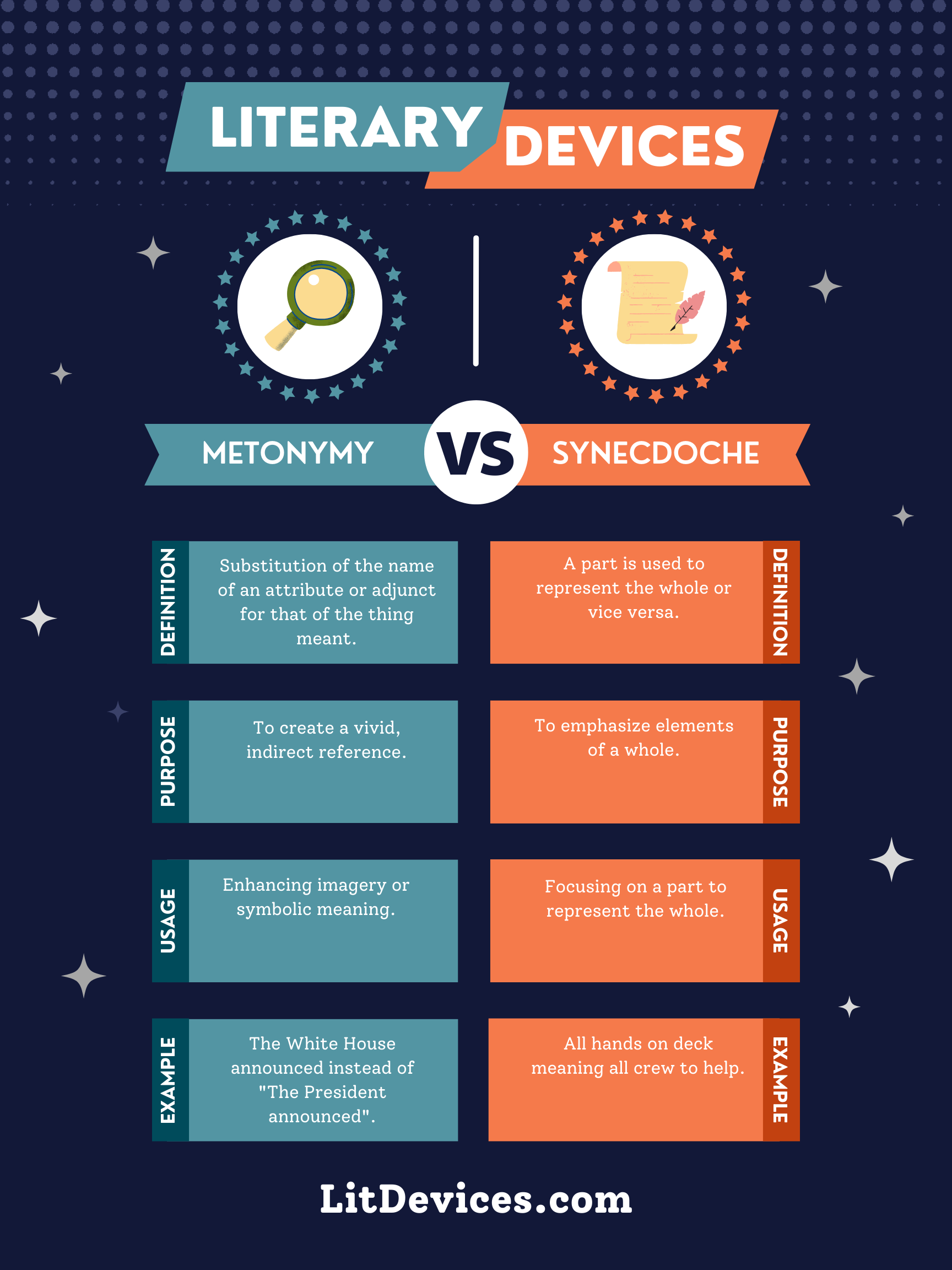Metonymy substitutes the name of one thing with something closely associated; Synecdoche uses a part to represent the whole or vice versa.
Metonymy 🔄
Metonymy is a figure of speech where something is called not by its own name but rather by the name of something intimately associated with that thing or concept. For example, when we say “The White House announced new environmental policies,” we’re not talking about the building itself making announcements, but rather the people who work within the U.S. administration. This device focuses on the interconnectedness of concepts and their associative meanings.
Synecdoche 🧩
Synecdoche, on the other hand, narrows down this association to a relationship of part to whole (or vice versa). A common example is using “wheels” to refer to a car. The “wheels” are a part of the car, but in synecdoche, the part is used to represent the whole. It’s a more specific kind of metonymy, honing in on the parts that make up a whole to give a more vivid, tangible understanding of what’s being talked about.
Summary
| Literary Device | Definition | Purpose | Usage | Relevant Examples |
|---|---|---|---|---|
| Metonymy | Substituting the name of a thing with an association | To leverage association for emphasis or clarity | Common in everyday language and literature | “The pen (writing) is mightier than the sword (warfare).” |
| Synecdoche | Using a part to represent the whole, or vice versa | To provide vividness or a tangible sense | Often used in poetry and creative writing | “All hands on deck” to mean all crew members must help |
Writing Tips
For writers eager to explore these literary devices, here are a few tips:
- Start with Observation: Pay attention to everyday phrases and idioms. Many are examples of metonymy or synecdoche.
- Practice with Synecdoche: Try describing objects or scenes by focusing on a defining part. For instance, “The sails (meaning the whole ship) vanished into the horizon.”
- Experiment with Metonymy: Link abstract concepts with concrete associations. “Hollywood (the place) is obsessed with youth (the concept),” not just talking about the physical location, but the entire film industry.
- Revise for Impact: Look for opportunities to replace direct statements with these devices to add depth and intrigue to your writing.
FAQs
Q: How can I quickly identify metonymy?
A: Look for a word or phrase used to stand in for something else that it’s closely related to, but not a part of.
Q: What’s the simplest way to understand synecdoche?
A: If a part of something is used to refer to the whole (or vice versa), you’re likely dealing with synecdoche.
Q: Can synecdoche be considered a type of metonymy?
A: Yes, synecdoche is often seen as a specific type of metonymy focused on the part-whole relationship.
Q: Are these devices only used in literature?
A: No, both are used in everyday language, advertising, and various forms of media.
Exercise
Consider the following sentences. Identify whether each example is metonymy or synecdoche:
- “He bought a Picasso.”
- “The world needs strong hearts.”
- “Silicon Valley is hiring.”
- “The restaurant has fifty mouths to feed tonight.”
Answers:
- Synecdoche (a part of Picasso’s work represents his entire collection).
- Metonymy (hearts represent people or courage).
- Metonymy (Silicon Valley represents the tech industry).
- Synecdoche (mouths represent people).
Other Device Comparisons You May Find Interesting
- Alliteration vs. Assonance: The dance of consonant and vowel sounds.
- Hyperbole vs. Understatement: Balancing exaggeration and subtlety.
- Irony vs. Sarcasm: The fine line between cleverness and scorn.
- **Simile vs. Metaphor**: Comparing the comparables and equating the equatable.
Exploring these devices further can enrich your understanding and use of language, adding depth and color to your writing and conversations.

